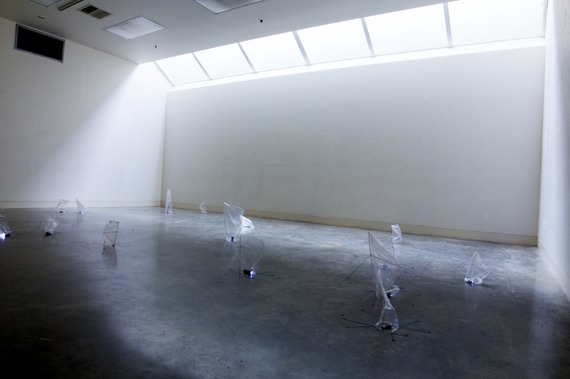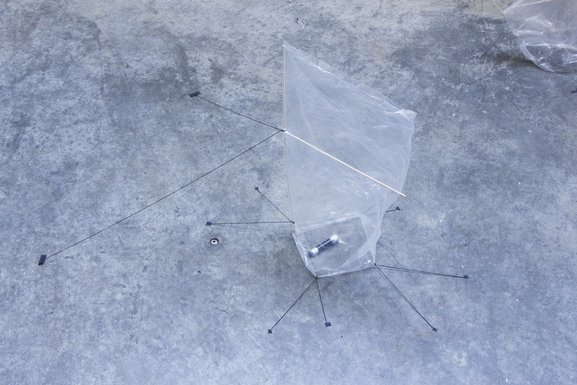Interstitial Spaces, 2014
To the Harbormaster
By Frank O’Hara
I wanted to be sure to reach you;
though my ship was on the way it got caught
in some moorings. I am always tying up
and then deciding to depart. In storms and
at sunset, with the metallic coils of the tide around my fathomless arms, I am unable understand the forms of my vanity
I am hard alee with my Polish rudder
in my hand and the sun sinking. To
you I offer my hull and the tattered cordage
of my will. The terrible channels where
the wind drives me against the brown lips
the reeds are not all behind me. Yet
trust the sanity of my vessel; and
if it sinks, it may well be in answer
to the reasoning of the eternal voices,
waves which have kept me from reaching you. 1
By Frank O’Hara
I wanted to be sure to reach you;
though my ship was on the way it got caught
in some moorings. I am always tying up
and then deciding to depart. In storms and
at sunset, with the metallic coils of the tide around my fathomless arms, I am unable understand the forms of my vanity
I am hard alee with my Polish rudder
in my hand and the sun sinking. To
you I offer my hull and the tattered cordage
of my will. The terrible channels where
the wind drives me against the brown lips
the reeds are not all behind me. Yet
trust the sanity of my vessel; and
if it sinks, it may well be in answer
to the reasoning of the eternal voices,
waves which have kept me from reaching you. 1
Interstitial Spaces
Inside, outside
To be in/through/of/among/with space
I mean you would walk in and wires would be glued and tied attaching a board casually leaning off the wall so that her light contraption was hung just right...she was concerned about the immensity of light and how it affected her eyes or even more my eyes as a child so that ultimately I had good sight when I got older.
There had to be enough light. And then the doors... open even in the cold of an Ontario winter so that there was always fresh air.
I don’t know where she came up with these notions and these objects. Maybe heritage or mere practicality but there were two things here of concern: the functionality of the object while using what was at hand and the comfort of the space in relationship to one’s wellbeing.
My concerns are an extension of her concerns: the space affects the chest’s opening and contracting; the object’s potential linking one to the quotidian experience and to oneiric potential.
In “Interstitial Spaces” clear plastic bags are turned over, held up by a crane of sticks and gaffing tape. A flashlight turned on in some of these structures fills the interior space of the bag illuminating outwards and blurring the distinction between the interior space of the bag and outside space. In form, like little tents or masts, they may lead one’s imagination to shelters or sails, and possibly even to the realm of the psychological and physical.2 Numerous of these small forms, no larger than one and a half feet high, occupy a room casting light over each other and reflect vague lines on the walls; an ambiguous drawing, a map to another imaginary space.3 Walking through this space the phenomenological experience is ‘a need to kneel down’ to the floor-level relating to smaller things in this world and then to the uncanny of the imagination.
‘Not fussy’, only temporarily palpable and totally ephemeral these objects are autonomous. The ad-hoc sensibility respectively follows a lineage of artists from Eva Hesse to Tony Feher and Isa Genzken. Also, influential to the work is the phenomenological in art and the movement ‘Art povera’ where Ammana wrote, “[was a] return to simple materials, revealing laws and processes deriving from the imagination... an examination of the artist’s own conduct in an industrialized society”4. A delicate touch and fragility is characteristically important to my work. The gesture is of a fine thread holding an entire space together and altering it.
1 O'Hara, Frank, and Mark Ford. Selected Poems. New York: Alfred A. Knopf, 2009. Print.
2 Bachelard, Gaston, and M. Jolas. The Poetics of Space. Boston: Beacon, 1994. Print. 3 Bachelard, Gaston, and M. Jolas. The Poetics of Space. Boston: Beacon, 1994. Print.
4Ammann, Jean-Christophe, ‘Zur Austellung’, Processi di pensiero visualizzati: Junge Italienische Avantgarde [cat.], Kunstmuseum. Lucerne, 1970
Inside, outside
To be in/through/of/among/with space
I mean you would walk in and wires would be glued and tied attaching a board casually leaning off the wall so that her light contraption was hung just right...she was concerned about the immensity of light and how it affected her eyes or even more my eyes as a child so that ultimately I had good sight when I got older.
There had to be enough light. And then the doors... open even in the cold of an Ontario winter so that there was always fresh air.
I don’t know where she came up with these notions and these objects. Maybe heritage or mere practicality but there were two things here of concern: the functionality of the object while using what was at hand and the comfort of the space in relationship to one’s wellbeing.
My concerns are an extension of her concerns: the space affects the chest’s opening and contracting; the object’s potential linking one to the quotidian experience and to oneiric potential.
In “Interstitial Spaces” clear plastic bags are turned over, held up by a crane of sticks and gaffing tape. A flashlight turned on in some of these structures fills the interior space of the bag illuminating outwards and blurring the distinction between the interior space of the bag and outside space. In form, like little tents or masts, they may lead one’s imagination to shelters or sails, and possibly even to the realm of the psychological and physical.2 Numerous of these small forms, no larger than one and a half feet high, occupy a room casting light over each other and reflect vague lines on the walls; an ambiguous drawing, a map to another imaginary space.3 Walking through this space the phenomenological experience is ‘a need to kneel down’ to the floor-level relating to smaller things in this world and then to the uncanny of the imagination.
‘Not fussy’, only temporarily palpable and totally ephemeral these objects are autonomous. The ad-hoc sensibility respectively follows a lineage of artists from Eva Hesse to Tony Feher and Isa Genzken. Also, influential to the work is the phenomenological in art and the movement ‘Art povera’ where Ammana wrote, “[was a] return to simple materials, revealing laws and processes deriving from the imagination... an examination of the artist’s own conduct in an industrialized society”4. A delicate touch and fragility is characteristically important to my work. The gesture is of a fine thread holding an entire space together and altering it.
1 O'Hara, Frank, and Mark Ford. Selected Poems. New York: Alfred A. Knopf, 2009. Print.
2 Bachelard, Gaston, and M. Jolas. The Poetics of Space. Boston: Beacon, 1994. Print. 3 Bachelard, Gaston, and M. Jolas. The Poetics of Space. Boston: Beacon, 1994. Print.
4Ammann, Jean-Christophe, ‘Zur Austellung’, Processi di pensiero visualizzati: Junge Italienische Avantgarde [cat.], Kunstmuseum. Lucerne, 1970
© Ebony Rose

